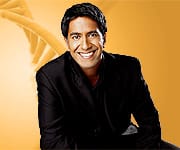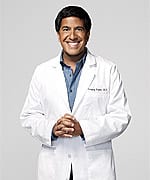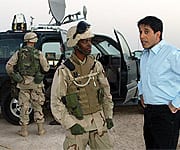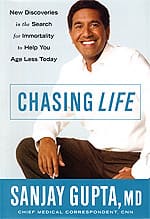Life Extension Magazine®
Turn on any television in the world—Beijing, Chicago, Tel Aviv, Rome, Los Angeles, or Tokyo—and you will find Dr. Sanjay Gupta reporting on the latest breaking medical and health news. As Chief Medical Correspondent for CNN, Dr. Gupta is currently the most famous and listened to doctor on the planet. Millions of viewers learn daily about advances in medicine that can change their lives. Additionally, Dr. Gupta is assistant professor of neurosurgery at Emory University Hospital and associate chief of neurosurgery at Grady Memorial Hospital, where he practices. Most recently, Dr. Gupta embarked upon a remarkable quest to investigate “new discoveries in the search for immortality to help you age less today.” For his investigation, he interviewed scientists around the globe from Okinawa and Russia to laboratories throughout the United States. His findings resulted in both a book and documentary titled Chasing Life (Warner Wellness). Dr. Gupta approached this broad subject from a unique perspective as both a practicing physician and as a seasoned journalist. In his search he left no subject, no matter how controversial, untouched. Chasing Life covers every imaginable topic, from caloric restriction and stem cell treatments to cryonics, resveratrol, and hormone supplementation. His goal was to assess the work of the best minds researching methods to slow aging and increase life span. Sifting through thousands of studies, Dr. Gupta wanted to present the best and most reputable practical findings that one can incorporate into their own life. The end product is a comprehensive overview of the latest developments in life extension.
The majority of Dr. Gupta’s findings echo those of Life Extension—from controlling inflammation and elevated homocysteine levels to the critical importance of fish oil supplementation. In his writings you can genuinely sense his excitement at the new discoveries occurring on a daily basis that will extend all our lives. He deems those who actively pursue a longer and healthier life as “Life Chasers.” As Dr. Gupta states in his book, “All over the world and right in your backyard, there are people who are steadily pushing back the frontier of aging. They are not content to simply wither away, becoming frail and feeling worthless. Instead, they are achieving a sort of practical immortality—living as long as they want to live and dying only when they are through living… Immortality is on the horizon and it is within our reach for the first time.” In this exclusive interview with Life Extension magazine, Dr. Gupta discusses his search for the latest advances in promoting a longer, healthier life span: LE: Extended longevity and the potential for immortality used to be the exclusive domain of science fiction. Now with quantum leaps in science and medicine, we are for the first time in history seeing the possibility of controlling and enhancing our life span. What were some of the more interesting life extension technologies that you came across in researching your book? SG: You are correct… our recent medical progress is astonishing. There’s something known as Moore’s Law, which means that we basically double our scientific knowledge every few years. What this really means is that we probably know twice as much now as we did in 1997, which wasn’t that long ago. I do believe in our lifetime that we will see the promise of stem cells, nanotechnology, and genomics able to tailor-make individualized medicine. All of these technologies are going to serve a large purpose toward making us live longer and healthier. A new kind of medicine is being created that will definitely break out of the realm of science fiction and become reality. There are places around the world where people are already doing this, such as Moscow, which I discuss in the book, and certainly Korea. LE: You spoke to a lot of scientists around the world to research your book. What one new technology seemed to be the most promising?
SG: Tissue engineering, with regard to stem cells, is very promising. We’re already able to use stem cells to basically improve cardiac function in someone who’s had a heart attack. The reason that this is so fascinating is that this therapy can now be applied and replicated, and also because cardiac cells and brain cells can now be regenerated. Previous to this technology, it was thought that once either of these types of cells died, that was it. This is no longer the case. And, once they have been regenerated, the person can get some of their original function back. For example, the heart function is measured by something known as ejection fraction. Ejection fractions actually improve in people who have stem cell therapies injected into their hearts. So, this looks to be a very promising new therapy. LE: In the book you profile the futurist Ray Kurzweil and the various methods he is utilizing to live longer. In summary, his theory is that in the not too distant future, medicine will be sophisticated enough to repair or cure a number of the major degenerative diseases. His position is that he is doing everything he can to live as long as possible and avoid the big killers like heart disease and cancer until medicine can actually deliver these new life-extending technologies. After hearing him propose this, what are your thoughts? SG: I think in the next couple of decades, we’re going to get to a point of practical immortality. It’s not true immortality, but practical immortality, meaning that we’re going to live much longer without getting sick, and as a result we’ll have many more functional years. It seems that we are going to get to the point where some people will be able to decide how long they want to live by doing some of the things that Kurzweil talks about. There is a lot of interest and activity around promising technologies such as exchanging body organs, rejuvenating cells, and even nanotechnology which will eliminate even a single cancer cell in the body before it can ever start replicating.
For a lot of people these ideas are on the fringe, but frankly now that I have researched it and spoken to the scientists in the field, I believe that we are getting very close to realizing some of these fantastic ideas. I think that we’re going to be much further along in the next twenty years than ever before. However, a lot of moving pieces need to come together for all of this to really work. When we think about how long people want to live there is an implicit understanding that they will be of strong mind and strong body. We can’t be assured that even though we might be able to replace a failing heart or replace failing kidneys with perfect genetically engineered matches, that their mind will necessarily be sharp. These are all factors that need to be taken under consideration. LE: In the last five years, it seems as if the possibilities of medicine have exponentially exploded. You can almost see the future happening right before our eyes. SG: That’s correct. Along that line of thought, right now there is a great deal of extremely sophisticated technology that a lot of people still don’t know about or even use. For example, I have a history of heart disease in my family. Previously you had to wait until you had a coronary event to really know what was wrong or even do something about it. Now, through noninvasive means, we can look at all of our coronary vessels—all the blood vessels in our heart. Just a few years ago, this didn’t exist and could be considered science fiction. Plus, there are medications that not only stop the production of plaque that narrows your blood vessels, but actually reverse it. This isn’t a life enhancing technology or medication that you have to wait for ten years for, this is now. There are people like Arthur Agatston, who’s a friend of mine, who says, “You know what, no one in this country needs to have a heart attack again.” LE: That’s a powerful declaration. Is it because of calcium score? SG: Calcium scores and even more, the CT angiograms. With the CT angiograms you’re not only looking at the narrowing of the blood vessel, but you’re looking at the health of the vessel wall itself, which is even better than an angiogram. And this is technology that exists right now. LE: Given all your research into longevity and new advances in medical therapies, what personally have you incorporated into your life? SG: I’ve actually thought about this quite a bit. There are three key areas of my life that I have changed. First of all, I never thought about mortality. LE: Well, you’re young. SG: I’m young and I think that for everyone, the sort of time is different as to when this becomes an issue for them. But typically, it’s associated with some life event—when they become sick themselves or have a brush with mortality, or something happens in their family. For me, it was the birth of my daughter. Her presence brought home the point that I want to be around for the milestones in her life. Not just alive, but present—of sound mind and sound body.
The second concept was the role of attitude and optimism in terms of living longer. There’s a phrase in Japanese called “ikigai,” which means “sense of purpose.” And the Japanese believe that the people who live the longest have a very strong “ikigai.” Every morning when you wake up, you focus on what is your sense of purpose for that day, what is your sense of purpose on earth, why are you here, what are you going to do, how are you going to better the world in some way? These are the sorts of questions that are just fundamentally a part of their cultural and psychological fabric. And I don’t think it’s something that many societies, including our society in the United States, deal with very much. We are, if you will, just getting by, from an “ikigai” standpoint. Now, every morning I wake up and I really reflect and take stock. One might call it a type of meditation. I can feel myself calming down, my heart rate calms down, my blood pressure’s probably better regulated, I just feel much more content. There is enough evidence out there that this type of behavior change can make a huge difference in your overall cardiovascular health and in your ultimate longevity. LE: There are numerous studies that show this type of mental regimen can help improve hormonal levels, including altering one’s cortisol levels. So besides realigning your mental attitude, what other changes did you make based on your investigations? SG: In addition to my mental exercise, the second item I focused on was my physical exercise. I’m a runner—I run a lot, and I do marathons—but I never really focused on strength training. Adding upper body resistance training appears to make a huge difference for several reasons. One is that it improves your posture, which just makes you feel better. Two is that it adds a little bit of muscle mass, which changes your metabolism. You’re talking about some very large muscle groups here. Your pectoralis, your deltoids, and your latissimus—big muscle groups that if you increase their muscle mass, you’ll tend to burn more calories even when you are at rest. The third benefit is warding off osteoporosis. Studies show that load-bearing exercise, much more so than aerobic exercise, makes you less likely to develop porous or osteoporotic bones. I think the biggest benefit of upper body training for “Life Chasers” is that if you are in a nursing home or you’re in a hospital for some illness, pneumonia is the biggest killer for older people. People who have better upper body strength and have better pulmonary excursion are much more likely to be able to fight off pneumonia. So, for “Life Chasers,” upper body training can benefit posture, it can aid weight management, ward off broken bones, and protect against idiopathic pneumonia. LE: That is a wide range of benefits. We’ve discussed your own program with regard to mental and physical exercise, what about food and supplements? SG: In terms of supplements, I take a multivitamin and fish oil. Based on the over one thousand articles I have read, I firmly believe that fish oil has important benefits that I need to incorporate into my personal program. It is a remarkable substance Interestingly, what fish oil accomplishes in the body is something that the pharmaceutical companies have been trying to accomplish for years. You may remember that Pfizer was trying to create a medication that lowered your LDL and simultaneously raised your HDL. Lipitor® lowers your LDL, but not your HDL. Niacin raises your HDL. At this point, there’s nothing that does both. However, fish oil seems to be one of the best substances at doing some of both. In terms of foods, I follow a very simple plan. If you eat seven different colored foods a day, you’ll pretty much cover all your nutritional bases. So these are three ways I changed my life: a sense of purpose or ikigai, upper body resistance training, and consuming the seven different colored foods each day, along with the addition of fish oils and a multivitamin. LE: In the book you discuss caloric restriction, which is one of the most widely studied and validated methods of increasing life span. Have you incorporated any of that data into your own life? SG: First of all, the science on caloric restriction appears to be pretty good. In the animal studies, it has been shown that you can prolong life span by about 35% in mice, which is significant. The primate studies are underway and they look very promising. There are now federal funds to underwrite the first human caloric restriction study. In terms of incorporating these ideas into my personal regimen, I actually have cut down my calories. I have never been a calorie counter, but I have become someone who does not satiate himself. Previously I would go out to eat in a restaurant and I would eat my meal until I was full. What I have learned, and it makes sense physiologically, as well as from a caloric restriction standpoint, is that if you slow down your eating, it takes about fifteen minutes for your stomach to send your brain a signal that you’re full. The problem is most of us finish a three-course meal in fifteen minutes, especially if we’re in a hurry, and we never give our brain a chance to catch up. So now, I slow down. I really try to enjoy my meals a little bit more. You know, we’re not talking about changing my entire scheduling, I’m talking about an extra ten or fifteen minutes. Also I eat more water-dense foods at the beginning of the meal, such as soups. Just the addition of soup can really make a difference. I probably have cut down my calories by about 20% as a result of that. The Japanese practice a similar concept and call it “harahachi bu,” which means to stop eating when you’re 80% full. It makes perfect sense physiologically. LE: On a daily basis you report the latest health findings to the world… how to avoid diabetes, how to lower cholesterol, the importance of fish oil supplements, etc. You would think that all this important health news about how one can improve their health would make everyone want to lose weight, exercise, and eat more carefully. Yet you look around and diabetes is now epidemic world wide; heart disease and cancer continue to claim untold lives on a daily basis. You must just shake your head and wonder what is the missing key to get people to take responsibility for their own health? SG: You know, it’s something we think about all the time, and it sounds as though you at Life Extension do as well. I think everyone has a switch that suddenly goes off for them that makes them want to chase life and lead a healthier, longer life. Like I said earlier, in my case it was a brush with mortality that made me want to research this subject and find out everything I could to enhance my life as well as those of my readers/viewers. For my father, it was after he had heart problems. Now he’s a very fit 60 year-old guy as a result of making new decisions as to how he was going to live. So it varies with each individual. The obesity epidemic in this country is quite troubling and puzzling. I toured the country with Bill Clinton last year; childhood obesity is his biggest post-Presidency domestic initiative. He said something very disturbing, “for the first time, our children have a good chance at having a shorter life span than their parents.” So all these advances that are in my book which can help everyone live longer are erased by this one problem. I honestly don’t have the answer on this one. This one issue is probably more complicated than just about any other health issue out there, as there are a host of contributing factors. We’ve become a shortcut society, our neighborhoods don’t feel as safe as they used to, kids don’t play outside, school programs are going in the wrong direction, recess is being cut, it’s hard to get nutritious lunches, and we have vending machines in schools. I didn’t have vending machines in schools when I was a kid. This may seem simplistic, but this is truly a multifaceted problem. I think that society as a whole has to make a real commitment to solving this problem. This is the cold war of our generation and it’s going to kill more people. Heart disease already claims five hundred thousand lives, and this does not factor in this new generation of obese people. I can’t even imagine what the future numbers are going to be like, now that you have the childhood obesity problem. It’s going to be a real societal obligation that has to include everything from watching the farm subsidy bill for corn syrup, which I think is a big killer, to requesting that the fast food industry really offer healthier choices and make those healthier choices available to kids, including their school lunch programs. There are lots of different ways to tackle this problem, but it urgently needs to be addressed. Right now we’re touring the country with a program called “Fit Nation.” Lance Armstrong joined me last weekend for our kickoff. I talk about this issue on my program all the time. You can tell I’m pretty fired up about this. Honestly, I can feel people’s eyes glazing over when I start talking about it. So we thought we would actually get off the television screens and go into communities and start developing grass roots programs that can help people. We’re doing things like painting numbers on sidewalks so you know that you walked a quarter of a mile, an eighth of a mile, a half mile. One city in Iowa bought something like ten thousand bicycles, which they just littered throughout the entire city. They said, “Instead of driving, just get on those bikes and ride. Then leave it and take another bike home.” This is not a new idea, as many European cities do that. There are so many things that need to be changed, but this is a good start. LE: What is your optimal goal for the documentary and the book, in terms of changing people’s thinking and behavior with regard to their health? SG: I wanted to give something to people that they could hang their hat on. I got into this business five years ago. Formerly, I was a speech writer at the White House and I also did a lot health policy issues. As you know I’m also a practicing doctor. What I hear often is that there’s a lot of clutter in terms of medical information for the public. It’s all very confusing for everyone, including the doctors. With the book and the documentary, I wanted to be able to look at the very best science that we have right now, 2007, and say “I’m a doctor who knows something about the media and I’ve done all this research for you.” I wanted to create something that would help people sort through all the information noise and make good decisions. I think we’ve done that and the reviews have been good. A lot of people read the book before it was published and all agreed that the science I presented was solid. My comments weren’t always favorable to what they do, but they had to agree that the science that I presented was solid. The book is truly evidence-based and not based on anecdotes. The stories are good and it’s optimistic about all the options that are currently available to us. LE: We wish you the best with the book and hope that it achieves your goal of positively influencing people to make more informed decisions about living longer, healthier lives. |





